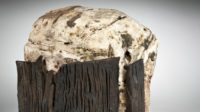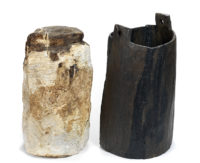 A new study has revealed that the practice of burying butter in bogs goes back even further in Irish history than we knew.
A new study has revealed that the practice of burying butter in bogs goes back even further in Irish history than we knew.
Previous analyses found that bog butters are made from animal fat, but because being buried in peat for a few thousand years can have mineralizing effects on organic matter. Some early studies concluded that it was adipocere, ie, tissue fat converted into a waxy substance in anaerobic condition, because the saturated fats in its chemical composition more closely matches those in adipocere (see this massive 77-lb stick). than in butter fat. Both theories got support in 2004 when a stable carbon isotope analysis of nine bog butters proved that six of them were the product of ruminant dairy and three from tallow, the carcass fat of ruminants.
The 2004 study looked at Scottish bog butter. The most recent study had a wider sample pool — 32 butters, and they are all Irish. The researchers also radiocarbon dated all of them to see if similar processes produced Irish and Scottish bog butters and if they could spot any trends over time. Of the 32 samples, the chemical composition of 26 of them identified them as ruminant dairy fat and another three were found to be likely from a dairy source. The remaining three samples could not be precisely classified.
 The radiocarbon dating results had a nice surprise. A sample of bog butter from Knockdrin was found to date from between 1745 and 1635 B.C.
The radiocarbon dating results had a nice surprise. A sample of bog butter from Knockdrin was found to date from between 1745 and 1635 B.C.
“We have known for a long time that bog butter was some sort of animal fat. However, compound-specific stable isotope analysis of the fatty acids in the degraded bog butters is the only way to identify the true origins of the fat – whether it was a milk fat like butter, or a carcass fat like tallow or lard.” said Professor Richard Evershed from the University of Bristol.
“Combining this analysis with radiocarbon dating, we obtain unparalleled insight into an extremely long-lived activity,” said UCD’s Dr Smyth.
“Together with two recently dated samples, this study brings to five the number of Bronze Age bog butters recorded from Ireland. Their date is extremely significant and pushes back known depositional activity by as much as 1500 years.”
Dr Smyth added: “Clearly, it is unlikely there was a single reason for the deposition of bog butter over four millennia. In certain periods they may have been votive deposits, while at other points in time it may have been more about storage and even protection of valuable resources.”
Professor Evershed notes that: “The widespread occurrence of these enigmatic butter deposits fits with our increasing knowledge of the central importance of dairying in prehistoric northern Europe.”
The study has been published in the journal Scientific Reports.